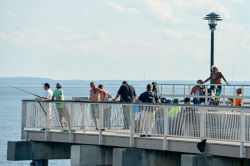Coney Island Beach & Boardwalk
Coney Island
Riegelmann Boardwalk/Coney Island Beach
Almost a century before the boardwalk opened along the Atlantic Ocean, Coney Island was on its way to becoming the nation’s most popular pleasure ground. In 1824 the Coney Island House was established as a seaside resort, and within a few decades it was attracting a steady stream of visitors, including celebrities. After the Civil War, new railroad lines provided direct public transportation to a rapidly expanding list of attractions: restaurants, hotels, bathing pavilions, shops, amusement rides, race tracks, theatres, and as always, the beach and the ocean. At the turn of the century, amusement parks—Sea Lion Park, Steeplechase Park, Luna Park, and Dreamland—offered rides, concessions and entertainment on a spectacular scale.
Once the BMT subway line reached the area in 1920, the pleasures of Coney Island were just a five-cent ride away from the steaming city. Attendance on a hot summer day could reach as high as a million, causing extreme congestion on the beach. Making matters worse, private concessions (such as beachfront hotels, bath houses, and cabarets) controlled large portions of the beach. As Brooklyn Borough President from 1918 to 1924, Edward Riegelmann (1869-1941) took charge of beautifying Coney Island and ensuring public access to the beach and shore. After the city secured title to property along the beachfront, the $3 million beach improvement and boardwalk construction began in 1921.
The immense engineering project required 1.7 million cubic yards of sand to add another 2.5 million square feet to the beach area. Construction of the boardwalk made use of 120,000 tons of stone, 7700 cubic yards of reinforced concrete, and 3.6 million feet of timber, including long leaf yellow pine for the flooring. From a height of 14 feet above the beach, the 80-foot wide boardwalk stretched from W. 37th Street to Ocean Parkway and provided easy access to both beach and concessions. "Coney Island's Fifth Avenue" opened with great fanfare on May 15, 1923.
Even during the Great Depression, the promise of fun at Coney Island continued to draw millions of visitors. New York City Parks Commissioner Robert Moses, however, wanted to replace the commercial amusements with better opportunities for "exercise and healthy outdoor recreation." Parks was awarded jurisdiction of the beach and boardwalk in 1938, and Coney Island was given a $3 million facelift. Between 1938 and 1941, Parks shifted and straightened out much of the boardwalk and extended it east to Brighton Beach. Also, the beach was greatly expanded and entirely resurfaced with a 2-foot layer of fine white sand. The boardwalk was named for Borough President Riegelmann. Since 1983 the boardwalk has hosted the annual Mermaid Parade, which welcomes the summer beach season with a wild procession of sea-people. In 1993 "The First Symphony of the Sea," a 300-foot long sculpture wall by artist Toshio Sasaki, was installed on the boardwalk outside the Aquarium for Wildlife Conservation. Riegelmann Boardwalk has been reconstructed numerous times since 1923, and many portions are now made of sturdy Bethabara, Ekki, and Cumaru hardwoods. Along a distance of 2.7 miles, from W. 37th Street to Corbin Place, there are 1.3 million boards and 15.6 million screws and nails (about 12 to a board). The boardwalk links the excitement of Coney's colorful amusements and the sweeping calm of beach and ocean. It is an enduring symbol of New York City and its most famous playground, Coney Island.
Check out your park's Vital Signs
Clean & Safe
Green & Resilient
Empowered & Engaged Users
Share your feedback or learn more about how this park is part of a
Vital Park System
Downloads
Contacts
Park Manager: (718) 946-1353










